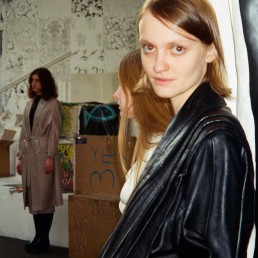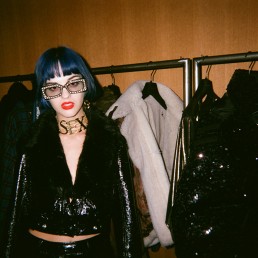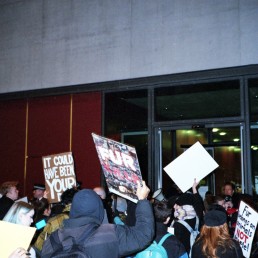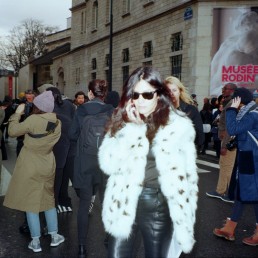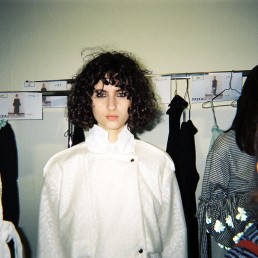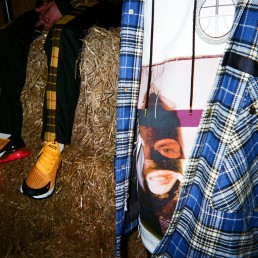Following selfFab. presentation at HKFG SS26 during Paris Fashion Week, Bennett Thyren was able to get in touch with the founder and creative director, Menu Tsai to discuss her inspirations, the evolution of selfFab.’s identity, and how she continues to shape her creative vision.
Founded in 2019 by Menu Tsai, selfFab. has begun to create a global audience drawn to their energetic and highly expressive collections. selfFab., short for Self-Fabulous are believers that fashion is the ultimate expression of one’s identity, culture, and of course, the self. Often drawing inspiration from the cities where the company is based: Hong Kong and Shanghai. Through this selfFab. has established a brand that is constantly re-inventing itself, with a major focus on heritage, storytelling, and personality.
Equally as important to selfFab is their commitment to sustainability. Menu Tsai and the rest of the team at selfFab are committed to reinventing fashion to become more environmentally conscious. For them, this means using reclaimed materials. selfFab has been able to take these discarded pieces and give them a new life, removing waste from the fashion system. Under the direction of Tsai, who is recognized for her work both nationally and internationally. With a background in advertising, and interest storytelling she has been able to apply this to her fashion practice. This is what ultimately has brought selfFab and their belief in “style with interpretation” to a global audience. Since its founding Tsai has also begun leading the FAB STUDIO. The FAB STUDIO is a cross-disciplinary space that fosters collaborations between fashion designers, artists, musicians, and much more.

selfFab. Photo by Nowfashion and Fashion Farm Foundation
You have mentioned that the cities that inspire you most are Hong Kong, Shanghai, and Tokyo. You visited Paris to present with HKFG., What inspires you here, and what parts of Hong Kong, Shanghai, and Tokyo do you think Paris, and Europe could take inspiration from?
What inspires me in Paris now is not just the visual elegance or heritage, but the way people carry that elegance so effortlessly. During fashion week, I love visiting exhibitions, vintage markets, and vinyl bars—not just for the aesthetic pleasure, but to observe how Parisians live with taste, not just wear it. There’s a refined ease in how they express personal style. That inspires me to think: What does it take to truly speak to a European audience? What elements are essential to connect, without losing yourself?
In contrast, the cities I come from—Hong Kong, Shanghai, and Tokyo—have a very different rhythm. They don’t have the same historical depth, but they thrive on remixing. There’s a raw urgency, a constant evolution, a mix of chaos and control. From them, I learned how to build identity in fragmented environments.
If Paris shows me how to refine, Asia teaches me how to reinvent, I think there’s value in both. And as a designer, I want to be the bridge.
In your newest collection, Hybridized armour and the previous RE:SYNTHDELIC, there is a lot of inspiration coming from 80’s electronic music, 19th century silhouettes, military aesthetics, and athletic uniforms. Why do you find it important to look back in time to make collections we see today?
To me, looking back isn’t about nostalgia — it’s about re-encoding meaning. Whether it’s 80s techno culture or 19th-century tailoring, I’m not interested in preserving the past as it was. I’m more curious about how it feels now. What emotional resonance can we extract from it? How does it reflect or challenge our current identities?
In SS25’s RE:SYNTHDELIC, we referenced the rhythm of 80s electronic music not just as a sound, but as a mindset — a rebellion against structure, a celebration of new energy systems. In SS26’s Hybridized Armour, we went even further back, drawing from Victorian silhouettes and military tailoring — systems of power, discipline, and coded identity — and clashed them with athletic uniforms and football jerseys, which are about movement, collectivity, and raw emotion.
For me, looking back is a way to unpack the codes that shaped us — and then remix them to say something new. It’s like cultural sampling. The past is full of signals, but it’s up to us to distort, bend, and reframe them into forms that speak to the present.
Tell me about your process. How does an idea go from design to a final garment? How do you source materials? What determines an idea you find to be worth following?
My process often begins with a feeling. It might be a visual impression, a cultural reference, or an emotional state — but rarely just a trend or aesthetic. I’m very driven by instinct and narrative: what is the story I want to tell, and what energy do I want the garment to hold?
Once I have a conceptual direction, I start building a visual world around it — collecting references from vintage football jerseys, military tailoring, streetwear, film stills, or even archival photography. Then I sketch, but not in a rigid way. Sometimes I experiment directly with AI visuals or drape fabric on a mannequin to explore silhouette and flow. Material sourcing is also part of the narrative. For the Remake series, we work with vintage or deadstock jerseys — each with its own history. Sometimes we even wait for the right fabric to “find us” — especially for special pieces that need a certain attitude or texture. Ultimately, every garment has to carry meaning, not just styling. That’s what makes it selfFab.: a piece of self-interpretation.

selfFab. Photo by Nowfashion and Fashion Farm Foundation
Your brand revolves a lot around personal expression and individuality. How do you incorporate these elements into your designs? Do you make sacrifices to uphold these values in your work?
Personal expression is the soul of selfFab. From the beginning, I built the brand around the idea that fashion should be a tool for self-interpretation — not just self-decoration. That’s why I’m drawn to deconstruction, hybrid silhouettes, and one-of-a-kind pieces. I like creating garments that don’t tell you who to be, but instead give you space to define yourself.
Whether it’s our Reimagined Jerseys made from vintage football kits or our oversized silhouettes inspired by emotional states — every design is a form of open language. I don’t believe in one fixed identity. I believe people are layered, complex, and constantly shifting. So our clothes are designed to move with you, not box you in.
Being a Designer from Hong Kong, what added challenges do you face? What is it about selfFab that has allowed you to reach a more global audience?
Being a designer from Hong Kong definitely comes with its challenges — but that’s also what shaped selfFab.’s identity.
We don’t have the same level of industry infrastructure as Europe or Japan. Resources are limited, production is expensive, and the fashion scene isn’t always supportive of experimentation or new voices. In some ways, we’re working from the margins. But I think that’s what gave me a unique lens.
Growing up in Hong Kong — a city that constantly balances contradictions, East and West, tradition and speed — taught me how to adapt, remix, and invent my own language. That’s the core of selfFab.: a brand that embraces hybridity, individuality, and cultural transformation.
I think we resonate globally because we’re not trying to follow trends. We’re telling a deeply personal story, but also deeply human — about identity, movement, freedom, and finding your own code in a world full of labels. That honesty — and the emotional depth behind our pieces — is what I believe connects us to people, no matter where they are from.
In your collections, you’ve taken inspiration from a multitude of sources, such as football kits and military looks to deal with cultural identity in Hybridized amour, and how to make clothes evolve in Re-Maestro. You do not ever want to be boxed in. How do you see selfFab continue to evolve given this fact?
selfFab. was never meant to be a brand with fixed rules — it’s a platform for ongoing transformation. What interests me most is not the aesthetic itself, but the meaning behind these symbols, and how they can be re-interpreted through personal and cultural lenses.
“Hybridized Armour” is about identity as layering — not a singular narrative, but a constructed one. And Re-Maestro was about evolution — how clothes can shift through time, usage, and context. That spirit of change is our constant. So for me, the evolution of selfFab. is built into its core — it’s not about having a signature look, but about having a signature attitude. One that says: you don’t have to choose one identity, one culture, one lane. You can be all of it. You can remix, reshape, reclaim.

selfFab. Photo by Nowfashion and Fashion Farm Foundation
How do you hope people who wear your clothes will feel?
I hope they feel seen, empowered, and free. selfFab. isn’t about dressing to fit in — it’s about dressing to express something real, something personal. Whether it’s confidence, rebellion, nostalgia, or vulnerability — I want our garments to become a kind of language for the wearer. A way to say: this is me, in this moment. Many of our pieces — especially the ones made from reworked jerseys or patchworked fabrics — carry past stories. But once someone puts them on, they start telling their story. That’s the beauty of it. I hope wearing selfFab. feels like claiming space for your identity, without needing permission or explanation.
As people see your collections, your clothes on the street, and in social media, what do you hope they feel, and what do you hope they take away?
When people see selfFab.—whether it’s on the runway, in the streets, or online—I hope they feel a kind of spark. Not just “oh, that looks cool,” but something deeper, like “this feels different… this feels personal.” I want them to sense the layers—not just in the fabrics, but in the stories, the memories, the identity codes we’ve stitched in. Maybe it reminds them of their childhood club. Or a city they love. Or simply gives them the courage to express a part of themselves they hadn’t shown before. What I hope they take away is this: Clothes can be armour. Clothes can be poetry. Clothes can be freedom. And style, at its best, is not about following, but about translating who you are.
Where do you see the future of fashion going, given the many challenges it faces today regarding sustainability and creating original ideas? How will you position your brand to exist in this future place?
The future of fashion, I believe, lies in intentional hybridity — not just in style, but in values. We’re entering a time where fashion must do more than just look good or be trendy. It has to stand for something, carry meaning, and still be able to adapt. Sustainability can’t just be a checkbox; it has to be part of the design DNA. That’s why selfFab. isn’t only about “eco-materials”—it’s about extending the life of clothes through modularity, remixing the old into new, and designing garments that people truly want to keep, wear, and evolve with.
At the same time, originality in fashion no longer means “starting from zero.” In fact, I think the most powerful ideas often come from reinterpreting fragments of the past, combining unlikely elements, and giving them a new rhythm. That’s what we’re doing with Reimagined Jerseys, or Hybridized Armour — we’re sampling culture like a DJ samples sounds, and remixing it into something both familiar and futuristic.
To exist in this future, selfFab. positions itself as a creative system, not just a brand. It’s modular, open to collaboration, and rooted in storytelling. I don’t think people want more stuff — I think they want more meaning, and more agency in how they wear, feel, and express themselves.
Working with vintage and sourced materials can be very challenging, but also very rewarding. While these sources have become a part of your design language, what has been a struggle you faced, and what’s the most fulfilling part of using vintage materials?
One of the biggest challenges is consistency. No two vintage jerseys or fabrics are the same — they age differently, their textures shift, and sometimes they arrive damaged or completely unexpected. That makes production complex and unpredictable. You can’t just design and reproduce at scale — every piece needs to be redesigned in real-time, responding to the material you receive. It’s not just designing a garment, it’s designing a system that allows for adaptation.
But that’s also the most rewarding part. Because when you work with vintage pieces, you’re not starting from a blank page. You’re inheriting stories — the sweat of a player, the typography of a forgotten era, the color-fade from decades of wear. And when you reconstruct it, you’re not just recycling — you’re remixing culture. You’re turning forgotten fragments into something with new energy, new context. It’s not the easy way, but it’s the most meaningful for me. Every piece feels alive — like it carries its own soul.

What is a message you would give to young designers, and what’s a message you would share with people struggling to find themselves in the world today?
Keep doing. Keep exploring. You don’t have to have everything figured out right away. Try things. Fail fast. Steal with intention. Remix without fear. The point isn’t to find your style in one go — it’s to keep building a language that’s yours. Even confusion is part of the process. Let curiosity guide you more than trends or expectations.
To anyone struggling to find themselves: You don’t need a perfect answer, you just need to stay in the conversation with yourself. It’s okay to be in between. In fact, that’s often where the most honest, raw beauty is born. Keep creating, keep feeling, keep moving. One day, you’ll look back and realize: you weren’t lost, you were just becoming.
-Interview by Bennett Thyren

selfFab. Photo by Nowfashion and Fashion Farm Foundation

selfFab. showcase at Fashion Farm Foundation Paris HKFG SS26
